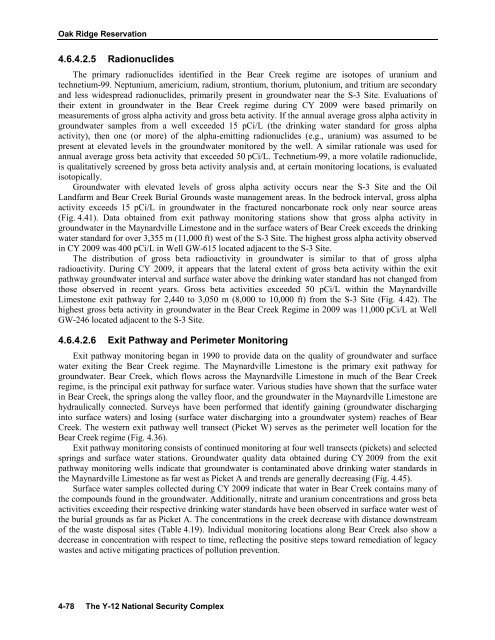DOE/ORO/2327 Oak Ridge Reservation Annual Site Environmental ...
DOE/ORO/2327 Oak Ridge Reservation Annual Site Environmental ...
DOE/ORO/2327 Oak Ridge Reservation Annual Site Environmental ...
Create successful ePaper yourself
Turn your PDF publications into a flip-book with our unique Google optimized e-Paper software.
<strong>Oak</strong> <strong>Ridge</strong> <strong>Reservation</strong><br />
4.6.4.2.5 Radionuclides<br />
The primary radionuclides identified in the Bear Creek regime are isotopes of uranium and<br />
technetium-99. Neptunium, americium, radium, strontium, thorium, plutonium, and tritium are secondary<br />
and less widespread radionuclides, primarily present in groundwater near the S-3 <strong>Site</strong>. Evaluations of<br />
their extent in groundwater in the Bear Creek regime during CY 2009 were based primarily on<br />
measurements of gross alpha activity and gross beta activity. If the annual average gross alpha activity in<br />
groundwater samples from a well exceeded 15 pCi/L (the drinking water standard for gross alpha<br />
activity), then one (or more) of the alpha-emitting radionuclides (e.g., uranium) was assumed to be<br />
present at elevated levels in the groundwater monitored by the well. A similar rationale was used for<br />
annual average gross beta activity that exceeded 50 pCi/L. Technetium-99, a more volatile radionuclide,<br />
is qualitatively screened by gross beta activity analysis and, at certain monitoring locations, is evaluated<br />
isotopically.<br />
Groundwater with elevated levels of gross alpha activity occurs near the S-3 <strong>Site</strong> and the Oil<br />
Landfarm and Bear Creek Burial Grounds waste management areas. In the bedrock interval, gross alpha<br />
activity exceeds 15 pCi/L in groundwater in the fractured noncarbonate rock only near source areas<br />
(Fig. 4.41). Data obtained from exit pathway monitoring stations show that gross alpha activity in<br />
groundwater in the Maynardville Limestone and in the surface waters of Bear Creek exceeds the drinking<br />
water standard for over 3,355 m (11,000 ft) west of the S-3 <strong>Site</strong>. The highest gross alpha activity observed<br />
in CY 2009 was 400 pCi/L in Well GW-615 located adjacent to the S-3 <strong>Site</strong>.<br />
The distribution of gross beta radioactivity in groundwater is similar to that of gross alpha<br />
radioactivity. During CY 2009, it appears that the lateral extent of gross beta activity within the exit<br />
pathway groundwater interval and surface water above the drinking water standard has not changed from<br />
those observed in recent years. Gross beta activities exceeded 50 pCi/L within the Maynardville<br />
Limestone exit pathway for 2,440 to 3,050 m (8,000 to 10,000 ft) from the S-3 <strong>Site</strong> (Fig. 4.42). The<br />
highest gross beta activity in groundwater in the Bear Creek Regime in 2009 was 11,000 pCi/L at Well<br />
GW-246 located adjacent to the S-3 <strong>Site</strong>.<br />
4.6.4.2.6 Exit Pathway and Perimeter Monitoring<br />
Exit pathway monitoring began in 1990 to provide data on the quality of groundwater and surface<br />
water exiting the Bear Creek regime. The Maynardville Limestone is the primary exit pathway for<br />
groundwater. Bear Creek, which flows across the Maynardville Limestone in much of the Bear Creek<br />
regime, is the principal exit pathway for surface water. Various studies have shown that the surface water<br />
in Bear Creek, the springs along the valley floor, and the groundwater in the Maynardville Limestone are<br />
hydraulically connected. Surveys have been performed that identify gaining (groundwater discharging<br />
into surface waters) and losing (surface water discharging into a groundwater system) reaches of Bear<br />
Creek. The western exit pathway well transect (Picket W) serves as the perimeter well location for the<br />
Bear Creek regime (Fig. 4.36).<br />
Exit pathway monitoring consists of continued monitoring at four well transects (pickets) and selected<br />
springs and surface water stations. Groundwater quality data obtained during CY 2009 from the exit<br />
pathway monitoring wells indicate that groundwater is contaminated above drinking water standards in<br />
the Maynardville Limestone as far west as Picket A and trends are generally decreasing (Fig. 4.45).<br />
Surface water samples collected during CY 2009 indicate that water in Bear Creek contains many of<br />
the compounds found in the groundwater. Additionally, nitrate and uranium concentrations and gross beta<br />
activities exceeding their respective drinking water standards have been observed in surface water west of<br />
the burial grounds as far as Picket A. The concentrations in the creek decrease with distance downstream<br />
of the waste disposal sites (Table 4.19). Individual monitoring locations along Bear Creek also show a<br />
decrease in concentration with respect to time, reflecting the positive steps toward remediation of legacy<br />
wastes and active mitigating practices of pollution prevention.<br />
4-78 The Y-12 National Security Complex











